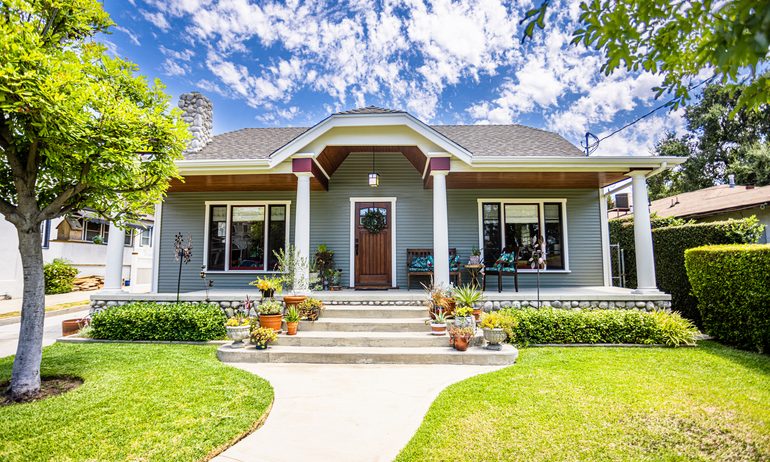How to Increase Home Value
Making your house more energy efficient, adding square footage, upgrading the kitchen or bath and installing smart-home technology can help increase its value.

Some or all of the mortgage lenders featured on our site are advertising partners of NerdWallet, but this does not influence our evaluations, lender star ratings or the order in which lenders are listed on the page. Our opinions are our own. Here is a list of our partners.
Some factors that impact your home's value, like location and the overall housing market, are out of your control. But you can still make a big difference by keeping up with repairs and making smart improvements.
Whether you want to build home equity or get top dollar when you sell, here are five ways to add value to your home.
1. Improve the exterior
Curb appeal — how your home looks from the street — is your first chance to make a good impression. The exterior should make a prospective buyer want to walk through the front door.
At bare minimum, maintain the landscaping. A bedraggled yard will turn off buyers and make them suspect the house isn't well tended. If your yard looks dull compared to others on the block, undertake some simple do-it-yourself projects, such as adding beds and borders or planting hardy ground cover and easy-to-grow flowers.
Then take an objective look at the outside of the structure itself. Replacing old features, such as doors and siding, can make a home look a lot better, and exterior replacement projects tend to give better returns on investment than many interior remodeling projects, according to Zonda Media's Remodeling 2024 Cost vs. Value Report. For example, the report says that replacing a garage door yields about a 194% return, on average, nationally.
2. Spruce up the interior
Updating the kitchen and bathrooms can boost value, but you don't have to spring for designer fixtures and custom cabinets. Modest projects to make these rooms more workable tend to yield better returns than luxury overhauls.
A minor kitchen remodel recoups 96% of its cost in added value on average, versus 38% for a major upscale kitchen remodel with stone countertops, custom cabinets and commercial-grade appliances, according to the Remodeling 2024 Cost vs. Value Report.
The same is true for bathrooms. A midrange remodel, including new flooring and updated fixtures, delivers a 74% return on investment, while an upscale bathroom remodel — including heated flooring, custom cabinets and designer fixtures — sees 45% on average.
3. Make it low-maintenance
Replacing a major component before putting your home up for sale — like the furnace, water heater or even the roof — may reassure prospective buyers and help fetch a higher price.
Improvements that make things easy to clean and maintain may also increase home value. Consider replacing easily stained carpet with hardwood floors or high-maintenance wood siding with vinyl siding.
4. Make it more efficient
Energy-conservation features can help lower utility bills and make a home more appealing to buyers. Windows, doors and siding were among the green home features that real estate agents believed were most important to their clients, according to a March 2023 survey by the National Association of Realtors.
Other options include enhanced attic insulation, LED lighting and efficient appliances. If you’re willing to go bigger, considering installing solar panels. Thirty-four percent of agents surveyed by the NAR said solar panels increased perceived property value. But since solar panels are a big financial and structural commitment, they only make sense if you’re hoping to increase value over the long term, not looking for a quick boost.
Schedule an assessment with a certified energy auditor or your utility company to determine where your home is wasting energy and which upgrades will save you the most money — even before you think of selling.
5. Make it bigger
Price per square foot is one way buyers compare similar homes, so bigger homes often command higher values. Even if an appraiser doesn’t officially acknowledge the full value of added space, a buyer will likely notice.
Adding a room is the obvious way to make your house bigger, but you can also create additional living space by finishing the basement or building a deck.
6. Make it smarter
Smart, safety-enhancing gadgets include thermostats, fire detectors, carbon monoxide detectors, security cameras, door locks and lighting.
While smart tech doesn’t always increase home value, it can add appeal.
Unlike replacing the roof or renovating the bathroom, you can usually install these devices yourself for about $1,000 or less.
How to pay for improvements that increase value
When thinking about how to increase home value, root your expectations in reality. Updates rarely recoup 100% of their cost, but they can make your family more comfortable and even help your home sell faster.
If you can’t pay for home improvements in cash, be sure to choose the right method of financing for you.
Credit card: Putting home renovations on a credit card may be OK as long as you’ll be able to pay off the entire balance in a short amount of time.
Personal loan: If you don’t have enough equity for a home equity loan or HELOC, consider a personal loan. The interest rate will be higher than home-equity-based financing, but lower than a credit card in most cases.
Home equity loan or line of credit: These second mortgages turn your home’s equity into easily accessible funds. Home equity loans pay out in a lump sum while home equity lines of credit, or HELOCs, are a line of financing you can borrow against over time. Both home equity loans and HELOCs have interest rates, fees, monthly payments and tax advantages to consider.
Cash-out refinance: This popular refinance option may be a good fit if you want to tap equity but don't fancy a second mortgage. But a cash-out refinance doesn't make sense if your equity is limited or current cash-out mortgage rates are higher than your existing rate. Explore all of these financing options with our home improvement financing calculator.
This article has been updated to reflect the most recent fact-checking as of April 28, 2025.








